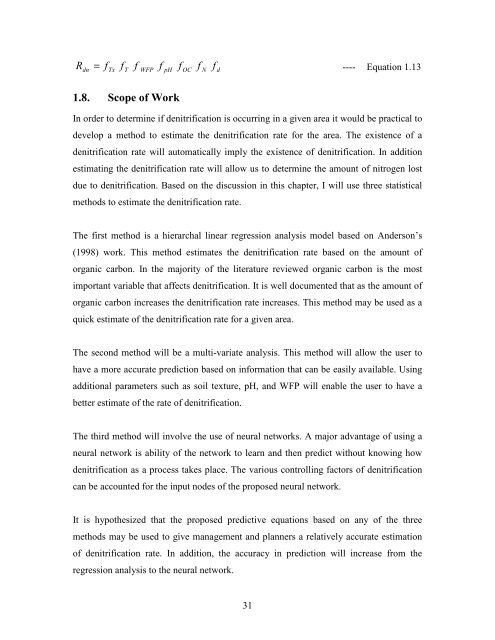THE FLORIDA STATE UNIVERSITY ARTS AND SCIENCES ...
THE FLORIDA STATE UNIVERSITY ARTS AND SCIENCES ...
THE FLORIDA STATE UNIVERSITY ARTS AND SCIENCES ...
Create successful ePaper yourself
Turn your PDF publications into a flip-book with our unique Google optimized e-Paper software.
R = f f f f f f f<br />
---- Equation 1.13<br />
dn<br />
Tx<br />
T<br />
WFP<br />
pH<br />
1.8. Scope of Work<br />
OC<br />
N<br />
d<br />
In order to determine if denitrification is occurring in a given area it would be practical to<br />
develop a method to estimate the denitrification rate for the area. The existence of a<br />
denitrification rate will automatically imply the existence of denitrification. In addition<br />
estimating the denitrification rate will allow us to determine the amount of nitrogen lost<br />
due to denitrification. Based on the discussion in this chapter, I will use three statistical<br />
methods to estimate the denitrification rate.<br />
The first method is a hierarchal linear regression analysis model based on Anderson’s<br />
(1998) work. This method estimates the denitrification rate based on the amount of<br />
organic carbon. In the majority of the literature reviewed organic carbon is the most<br />
important variable that affects denitrification. It is well documented that as the amount of<br />
organic carbon increases the denitrification rate increases. This method may be used as a<br />
quick estimate of the denitrification rate for a given area.<br />
The second method will be a multi-variate analysis. This method will allow the user to<br />
have a more accurate prediction based on information that can be easily available. Using<br />
additional parameters such as soil texture, pH, and WFP will enable the user to have a<br />
better estimate of the rate of denitrification.<br />
The third method will involve the use of neural networks. A major advantage of using a<br />
neural network is ability of the network to learn and then predict without knowing how<br />
denitrification as a process takes place. The various controlling factors of denitrification<br />
can be accounted for the input nodes of the proposed neural network.<br />
It is hypothesized that the proposed predictive equations based on any of the three<br />
methods may be used to give management and planners a relatively accurate estimation<br />
of denitrification rate. In addition, the accuracy in prediction will increase from the<br />
regression analysis to the neural network.<br />
31
















